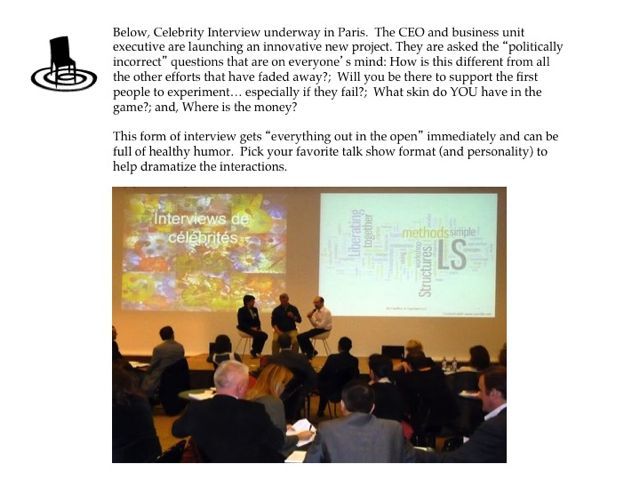![]() Celebrity Interview
Celebrity Interview
Reconnect the Experience of Leaders and Experts with People Closest to the Challenge at Hand (35-60 min.)
What is made possible? You can enable a large group of people to connect with a leader or an expert (the celebrity) as a person and grasp the nuances of how that person is approaching a challenge. With a well-designed interview, you can turn what would otherwise be a passive, often boring presentation into a personal narrative that is entertaining, imparts valuable knowledge, and reveals the full range of rational, emotional, and ethical/moral dynamics at play. You can often turn the interview into an invitation to action, drawing out all the elements needed to spark the participant group’s imagination and encourage cohesive action.
Five Structural Elements – Min Specs
1. Structuring Invitation
- Invite the celebrity to let go of his or her formal presentation or speech and answer the harder questions on everyone’s mind in a casual “talk show” format
- Invite group members to listen, see the person behind the celebrity, and write down questions with colleagues
2. How Space Is Arranged and Materials Needed
- Interviewer and celebrity in the front of the room where everyone can see and hear the interaction (lapel microphones, bar stools, or living-room furniture recommended)
- Unlimited number of people in a space where they can sit to view the interview and later form small groups (theater-style seating is OK)
- 3-by-5-inch cards to collect questions generated via 1-2-4
3. How Participation Is Distributed
- Part one, interview: everyone has an equal opportunity to listen
- Part two, questions: everyone has an equal opportunity to engage with one another to formulate questions
How Groups Are Configured
- Whole group for interview
- Individuals, pairs, small groups for 1-2-4 to generate questions
Sequence of Steps and Time Allocation
- Interviewer welcomes and introduces the celebrity and topic to be discussed. 3 min.
- Interviewer asks questions that the audience would be expected to ask (both humor and gravity are appropriate). 15–30 min.
- Invite participants to generate additional questions in a 1-2-4 conversation and then on 3-by-5-inch cards. 5–10 min.
- Interviewer sifts the cards, looking for patterns and asking additional questions to the celebrity. 5–10 min.
- Interviewer makes closing comments, thanks the celebrity. 1 min.
WHY? Purposes
- Create or boost a connection between an expert or leader and an audience
- Give substance and depth to a topic
- Avoid boring lectures and PowerPoint presentations
- Engage every individual in generating questions for further exploration
- Shed light on the person behind the position or expertise
- Bring big concepts to life with stories that come out in the interview
Tips and Traps
- A good sequence of starting questions is: What first inspired you in this work? What challenges you in this work? What keeps you going in this work? What do you hope can happen for us in this work?
- Give the questions to the celebrity in advance
- If possible, send background materials to participants in advance
- Do not allow the introduction to become a minilecture
- Interview questions should not be trivial or easy to answer
- Interviewer must ask repeatedly for stories and concrete details that illustrate concepts
- Interviewer may ask the celebrity, “Why is _____ important to YOU (not the larger organization or system)?”
Riffs and Variations
- Have fun with riffs from the talk-show genre: channel Oprah, Stephen Colbert, or your favorite celebrity interviewer
- The interviewer can conduct research in advance of the session, asking participants, “What do you want to know but would not dare to ask? What is the most important thing you want to know about this person or the work ahead?”
- Use a storytelling template to structure your interview (e.g., the Hero’s Journey).
- For strategy sessions, dig deeper into challenges by asking: What is happening around us that demands creative adaptation? What happens if we do nothing? Given our purpose, what seems possible now? If our current strategies were obliterated last night, what parts would you bring back today?
- Use with virtual groups. Conduct the voice/video interview while inviting all other participants to develop questions and comments in pairs or groups. Share the top questions via the chat function to “all” when the interview is complete.
- String together with User Experience Fishbowl, Open Space, DAD, and What I Need From You
Examples
- For a leader or leaders to help launch a new initiative
- To welcome and get to know a new leader coming into the organization
- To personalize and deepen the contributions of an expert
- For debriefing the experience of a few participants in an important event
- As an alternative to a case-study presentation: the interviewer helps to revive the story and the local context underneath the analysis
Attribution: Liberating Structure developed by Henri Lipmanowicz and Keith McCandless. Inspired by seriously playful improvisers in Venezuela.

